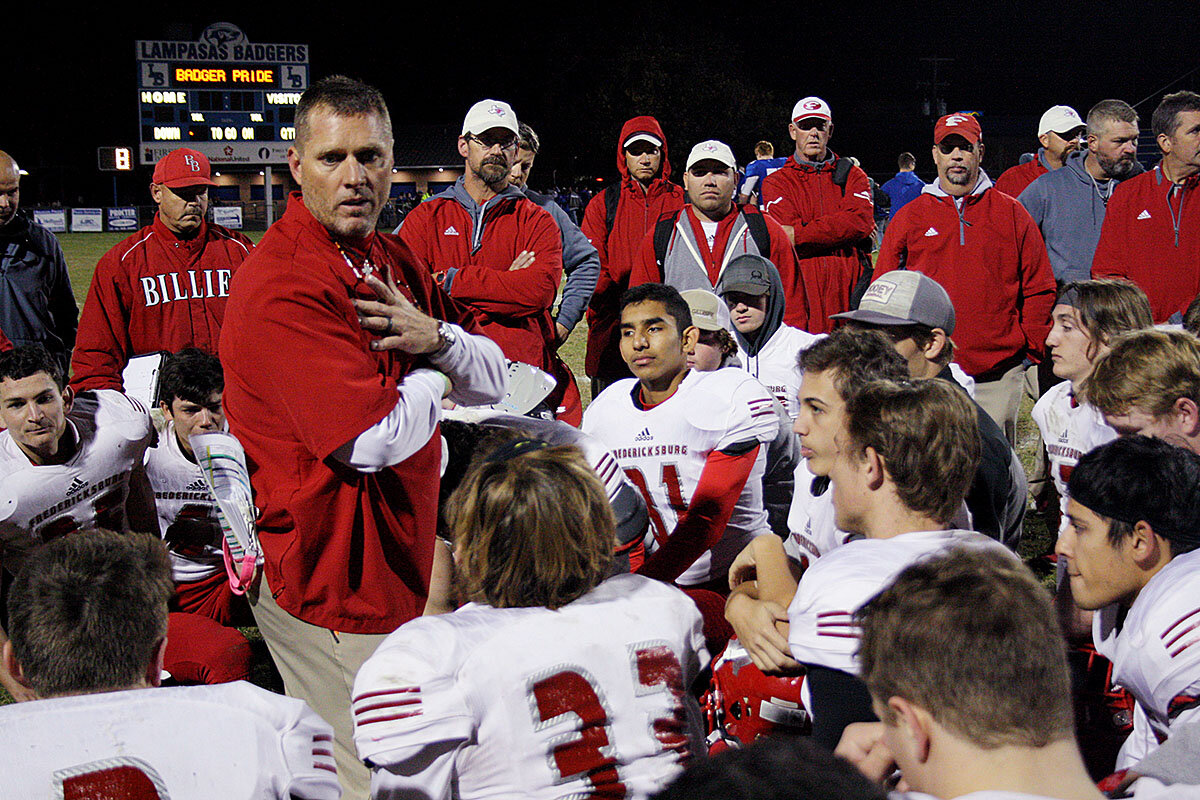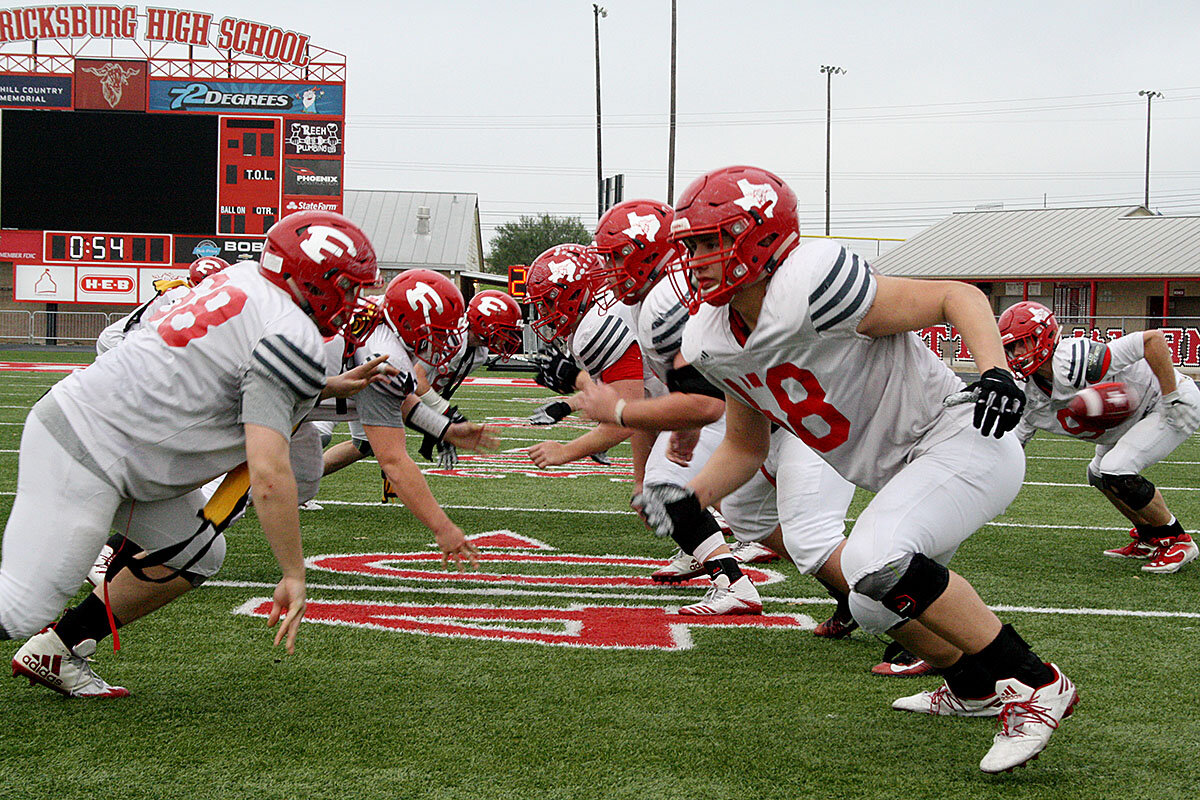How Texas wants to save football from concussions
Loading...
| Fredericksburg and Lampasas, Texas
It is 6:30 a.m. on a Monday, and the fields around this small town stir with cows, goats, and of course, the high school football team.
Nestled in the heart of Texas Hill Country, Fredericksburg could be any town in the state on this morning in early November. It’s the last week of the high school football regular season, and Lance Moffett, the Fredericksburg High School head football coach, is preparing for the make-or-break game to get his team into the playoffs.
In some ways, Mr. Moffett experienced so many mornings like this one as a high-schooler outside Dallas in the 1980s. Yet the practices he runs are far removed from his high school days. Today, he is trying to save his state’s most beloved sport.
Why We Wrote This
Safety concerns have made high school football controversial. The view from Texas shows those challenges but also how the drive to make football safer has focused on saving the good the sport does.
Like in other high schools around the country at the time, Moffett was coached to lead with “the screws” of his helmet – hit head-first and hard, in other words – when tackling. He had five concussions that he’s certain about – the ones a doctor diagnosed – but it could be more.
Back then, when he got his “bell rung” he would just sit out a few plays. Now, with research linking concussions to severe brain damage and death, he is doing exactly the opposite.
From peewee to professional, football is under enormous pressure to protect its athletes from concussions and other head injuries. In some quarters, head injuries are seen as to the game’s future. Participation in high school football has declined nationally.
But Texas is an interesting case. High school football is a core part of the state’s identity, and so perhaps more insulated from the push for change. Indeed, participation in high school football here has in recent years. Yet having football at the heart of Texas culture adds its own pressure. Kids of all shapes and sizes will show up to play, but if they aren't protected that culture could erode.
So change is taking hold. When Moffett played in high school “it was virtuous to knock the crap out of people,” primarily by leading with your head, he says. Today, there is an increasing awareness of – and commitment to – keeping football thriving in Texas by keeping the head out of the game as much as possible.
“Can [high school football] continue to be the state jewel it has been for a very long time? Yes, I think it can be,” says Jamey Harrison, deputy director of the University Interscholastic League (UIL), the administrative body for high school sports in the state. “But what it will continue to require is to push and continuously make it as safe as we can.”
“We’re much more professional now than we certainly were 30 years ago,” says Moffett.
Practice makes improvement
Sitting in his office after practice, Moffett squirms slightly when discussing how things have changed. He doesn’t want people thinking his coaches were callous.
“The reason people like me maybe get defensive about it is because we’ve always had child safety as our No. 1 deal,” he says.
His coaches “thought it was safe [to tackle] as long as you had your head up and your spine aligned. They thought it was safe to lead with your face,” he adds. “The definition of safety has certainly changed in my career. I don’t think the concern for safety has changed.”
When Moffett played, full-contact scrimmages could last entire practices. Today, teams are restricted to eight hours of practice a week, of which a maximum of 90 minutes can be full-contact. Even at full-contact, coaches are quick to stop play right after hits, and players are told not to run through tackles or drag each other to the ground. (After head-to-head contact, the most frequent cause of concussion in football is head-to-ground.)
Fredericksburg’s coaches all got certified in concussion management several years ago, and over the summer most of them got certified in “rugby-style” safe and effective tackling, which involves using shoulders instead of heads.
Technology has also been a big game changer. Helmets are designed to distribute energy from impacts more evenly. But there are only so many new gizmos Moffett can get, and it can feel as if new technology is arriving every week.
“I’ve got to work within a budget. I’ve got to decide how much money I can spend per kid, and I’ve got to spend it on all my kids,” Moffett says. “It’s kind of the wild, wild West right now.”
If players are diagnosed with a concussion, they instantly enter a written into state law in 2011. They are out for a minimum of 12 days – they can’t practice for seven days, or longer if they still have symptoms, and then have to wait five more days before they can play again.
Next season the UIL will be introducing another new policy: The state’s largest schools will report every concussion incident. The information will be relayed to researchers at the University of Texas Southwestern Medical Center for study. It will make Texas the second state, after Michigan, to .
A decision for parents
Of course, rules only work if they are followed.
Donna and Troy Yarbrough of Santa Fe, Texas, say that two years ago their son was scrimmaging twice a day against the varsity defensive line, even though he was on the junior varsity. When he complained of a headache and nausea, a trainer told him to sit out the next practice. He did, but the symptoms continued. A doctor diagnosed him with a concussion, adding that he’d had at least one undiagnosed concussion, perhaps more.
Today, he still gets migraines, and he hasn’t played football since. His parents have filed against the school district, joining a rising number of similar suits being filed around the country.
The Santa Fe school district didn’t respond to a request for comment. Sherry Chandler, a lawyer representing the Yarbroughs, says the suit is about emphasizing safety over a “win at all costs” culture.
“We’re not trying to stop all football in this country,” she adds. “It just needs to be done safer and smarter.”
Bans have been proposed. Lawmakers in five states introduced bills this year to . Bennet Omalu, the scientist who was the subject of the 2015 film “Concussion,” has called youth football and said that nobody under 18 should play it.
Other experts say banning high school football would be an overreaction. Uzma Samadani, a neurosurgeon and brain injury researcher at Hennepin County Medical Center in Minneapolis, says she sees similar or worse injuries in basketball and swimming. The science on how concussions affect brain function is also much less clear than is often portrayed.
There is a consensus that brain injuries have both short- and long-term consequences, but “what we don’t understand is the relationship between brain injury and all the other things going on in a person’s life,” says Dr. Samadani.
Many also point to football’s developmental benefits, such as building mental resilience and teamwork. “Children benefit far more from football than we realize,” adds Samadani. “If we eliminate it as a sport, I’d be worried that those children would find other ways to injure themselves and not have any benefits.”
Several current and former high school coaches told the Monitor they don’t see a need for kids to play tackle football before seventh grade where, in Texas at least, coaches are professionally certified.
“What parents have to decide is: are the virtues of the game more valuable than the risk?” says Moffett. “If you can teach the virtues at home, through your church,… then don’t play football. But there’s a bunch of kids that don’t get that, and this is where they get it.”
In Texas, the risk and virtues are never too far from the surface.
At an early September game against Kerrville’s Tivy High School, three Fredericksburg players got concussions. But Tivy Antlers football is precious in town. More than 4,000 people show up for home games, and Antler gear is as common a sight in town as college or pro jerseys.
“Kids want to be part of the football team,” says David Jones, Tivy’s head football coach. “So it’s our job as coaches to protect them the very best that we can.”
And while some pro players – lamenting the lost “toughness” of the game – young kids “have never known it the other way,” says Mr. Jones. “What they know is what we’ve told them, how we’re going to do it now, and that’s all they care about.”
Friday night lights
It’s the night the Fredericksburg Battlin’ Billies have been practicing for. At 5-4, the Billies need to win to make the playoffs. The players charge onto the field through an inflatable tunnel crowned with a red billy goat led by Navy JROTCs carrying the American, Texas, and school flags. The Billies’ red helmets shine under the floodlights.
The game is away and the aluminum bleachers at Badger Field in Lampasas lean over the field just a few feet from the sidelines, crowded with spectators layered in sweaters and blankets. The game see-saws back and forth, with Fredericksburg falling behind 35-13 before an improbable comeback – including a long touchdown and a successful onside kick – brings them within two points, 49-47.
Fans on Billies’ sideline are on their feet, blankets forgotten, rattling cowbells and cheering. But on a crucial fourth down late in the game, Lampasas quarterback Ace Whitehead runs a sneak for the yard-and-a-half Lampasas needs. First down. Game over.
Minutes later, the Billies are kneeling near the halfway line. Some players are in tears. Moffett has his hat tucked under his folded arms, his playbook stuffed in his back pocket. “I love all of you,” he says.
“It’s not about winning and losing, it’s about being a team and supporting each other,” he continues. “You’re going to hurt, but you’ll be there for each other.”
There were no concussions or serious injuries in the game. There was a first-half embarrassment, a spirited comeback, and, ultimately, heartbreak.
These are the moments Texas wants to save.
“Football is one of the only avenues that you can teach a kid to get knocked down and get beat up and have to get back up,” says Jones. “It teaches you that that person next to you is a heck of a lot more important than you, and I don’t know where else you learn that.”
“I’ve never been into the toughness of the sport, that’s never been my motivation… I don’t have any qualms about the [safety] changes,” he adds. “We can put our head in the sand and say we don’t like it, but the truth is it’s here.”







